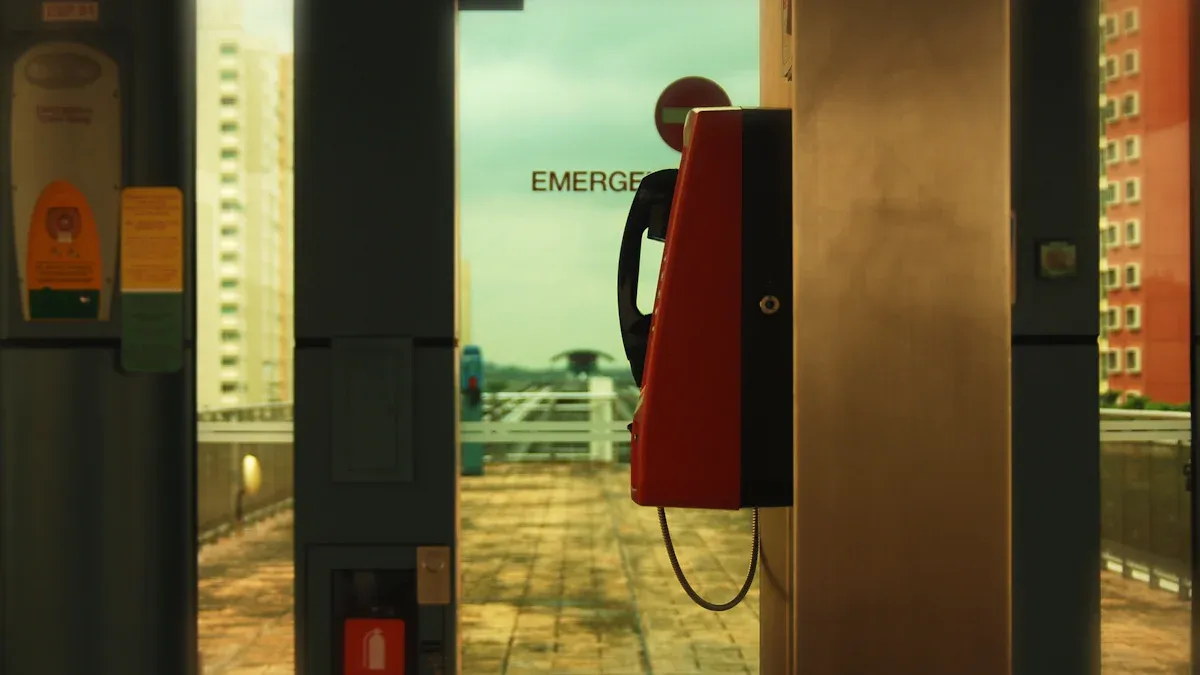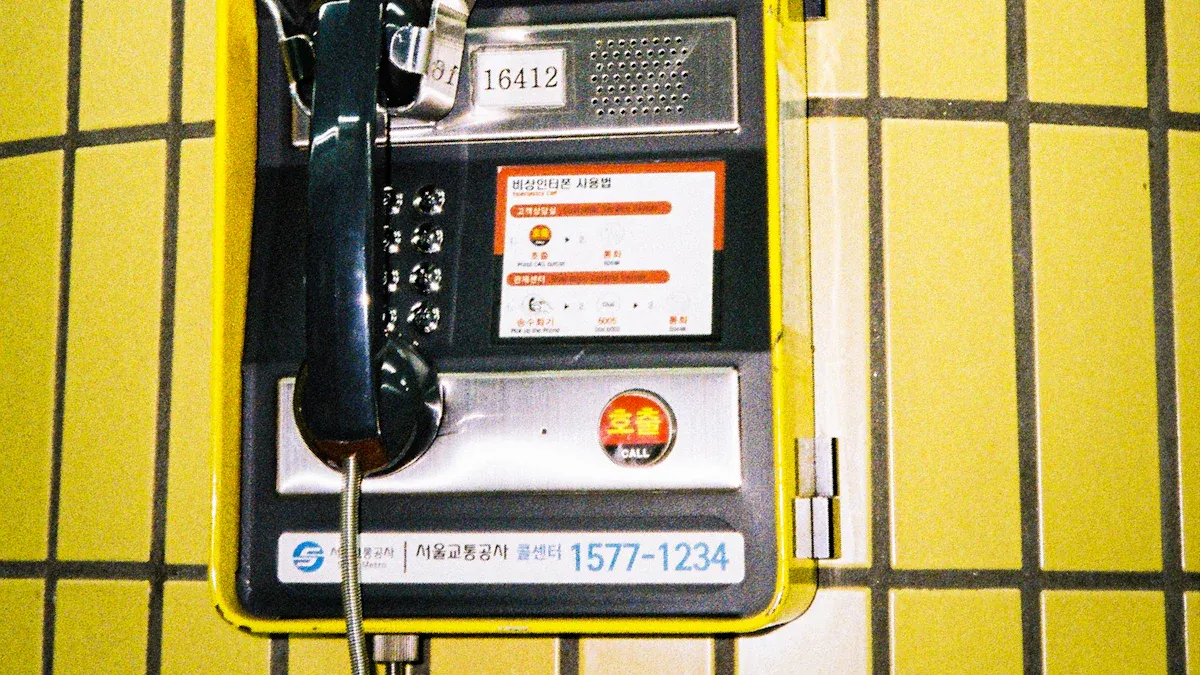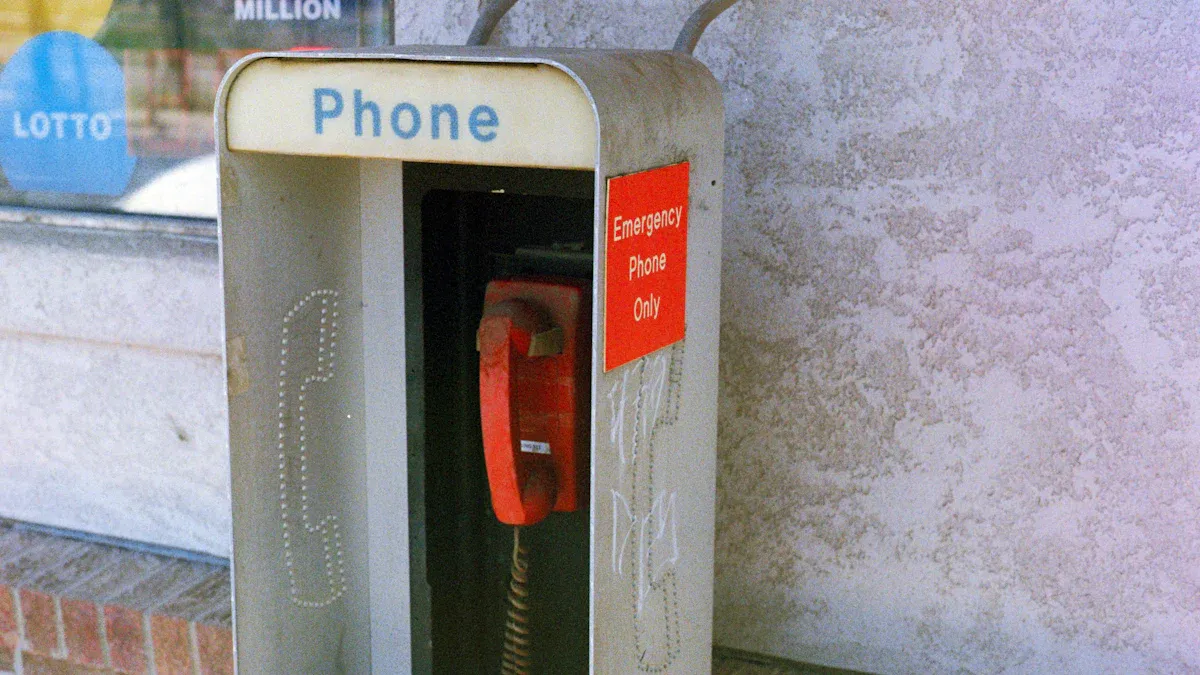
A rugged emergency telephone ensures swift communication during workplace crises. Many industries, including construction and logistics, rely on these devices due to their proven ability to reduce response times. Facilities often deploy an auto dial emergency telephone, 교통 비상 전화, 또는 SOS 비상 전화 to maintain safety in harsh environments.
Rugged Emergency Telephone: Definition and Purpose

What Is a Rugged Emergency Telephone?
A rugged emergency telephone serves as a dedicated device for urgent communication in challenging environments. Companies install these phones in places where regular phones might fail, such as factories, tunnels, or outdoor sites. The main goal is to provide a reliable way for people to call for help during emergencies. Unlike standard phones, these devices often feature simple controls, such as a single button for direct connection to emergency services.
Note: Many people believe that rugged emergency telephones are bulky or only for government use. In reality, modern models are compact and user-friendly. Businesses, remote workers, and even travelers use them for safety. These devices work even when cell phones lose signal, making them essential in remote or hazardous areas.
Durability and Industrial Standards
Manufacturers design rugged emergency telephones to withstand harsh conditions. They use strong materials like cold rolled steel for the body, which protects against impacts and vandalism. These phones often carry weather resistance ratings such as IP65 or IP66, meaning they block dust and water. Most models operate in extreme temperatures, from -30°C to +65°C, ensuring they function in both freezing and hot environments.
A table below highlights key durability features:
| Feature | 이름 * |
|---|---|
| Weather Resistance | IP65/IP66 ratings for dust and water |
| Material | Cold rolled steel body |
| Temperature Range | -30°C to +65°C |
| Certifications | CE, FCC, ROSH, ISO9001 |
These technical standards and certifications help businesses choose devices that meet safety and quality requirements. Rugged emergency telephones remain dependable, even when the power grid fails, because they can use backup power sources.
Security Benefits of Rugged Emergency Telephones
신뢰할 수있는 비상 통신
A rugged emergency telephone provides dependable communication during critical moments. Standard telephones often fail in harsh environments, but rugged models continue to operate. Several features contribute to this reliability:
- Cold rolled steel or stainless steel housings protect against vandalism and impact.
- Weatherproof and corrosion-resistant handsets withstand rain, dust, and extreme temperatures.
- High IP protection ratings, such as IP65 and IP66, block dust and water.
- Tamper-resistant fixings prevent unauthorized access or damage.
- High ringer volumes, reaching up to 110dB at one meter, ensure calls are heard in noisy areas.
- Power supply options, including telephone line power and Power over Ethernet (PoE), keep the phone working during outages.
- Non-volatile memory and remote programming capabilities support ongoing maintenance.
- Full duplex communication and hands-free operation make emergency calls easier.
These features ensure that a rugged emergency telephone remains operational when standard devices might fail. Facilities that use these phones can maintain communication even during power failures or severe weather.
Enhanced Safety for Employees and Visitors
Rugged emergency telephones play a key role in protecting everyone on site. Employees and visitors can quickly report emergencies or request help, no matter where they are in the facility. These devices support real-time accountability and rapid response.
- Quick roll calls and live personnel tracking help emergency teams locate people fast.
- Devices synchronize with access control systems, keeping occupancy information up to date.
- Offline mode allows data recording even when the network is down, syncing later when restored.
- The system provides missing persons lists with ID photos and last known locations, helping first responders act quickly.
- Multi-modal mustering options, such as badge scanning and facial recognition, speed up identification at muster points.
These capabilities ensure that everyone receives help promptly. The rugged hardware keeps working in tough conditions, supporting compliance with safety regulations and improving emergency response.
Tip: Facilities should train staff and visitors on how to use emergency telephones. Clear instructions and regular drills increase confidence and reduce panic during real emergencies.
Crime Deterrence and Fast Incident Reporting
Rugged emergency telephones also help deter crime and enable quick incident reporting. When people know that reliable communication tools are available, they feel safer and more secure.
- Centralized incident reporting systems allow security teams to detect and respond to threats quickly.
- Real-time data access and trend analysis help identify vulnerable locations and prevent future incidents.
- Robust communication tools support proactive security measures, reducing risks for staff and visitors.
For example, a major telecommunications company used a risk intelligence platform to centralize incident reporting. The security team could analyze theft trends, predict vulnerable spots, and act quickly to prevent further incidents. As a result, the company saw a significant reduction in crime, including several months without any incidents at retail locations. Reliable emergency telephones play a similar role by enabling fast reporting and response.
Compliance with Safety Regulations
Many industries must follow strict safety regulations. Rugged emergency telephones help businesses meet these requirements by providing reliable, accessible communication tools.
- Devices comply with standards such as CE, FCC, ISO9001, and RoHS, ensuring quality and safety.
- Integration with access control and mass notification systems supports instant communication during emergencies.
- Features like hands-free operation and high visibility make these phones accessible to everyone, including people with disabilities.
By installing rugged emergency telephones, companies demonstrate their commitment to safety and regulatory compliance. This not only protects employees and visitors but also reduces the risk of fines or legal issues.
Essential Features of a Rugged Emergency Telephone
Weather and Vandal Resistance
A rugged emergency telephone must withstand harsh weather and resist vandalism. Manufacturers use stainless steel or cold rolled steel for the housing, which protects the device from impact and tampering. Many models include a 파우더 코팅 마감 and brushed stainless steel faceplates secured with security screws. These features prevent rust, corrosion, and graffiti damage. The shell often contains a grounding device and electromagnetic shielding, which adds another layer of protection. Internal components, such as the handset and circuit board, use multi-layer waterproof and dustproof materials. Polycarbonate housings shield LED lights, ensuring visibility and durability in all conditions.
Accessibility and Visibility
Designers focus on making these phones easy to find and use during emergencies. Bright colors like safety yellow and LED lights help people spot the phone quickly, even at night. Illuminated call panels and backlit number pads improve usability in low-light areas. Many models feature a single, oversized button for fast activation. Durable steel or aluminum construction ensures the phone remains functional after heavy use or attempted vandalism. 모듈 식 디자인 allow for future upgrades and flexible installation.
Security System Integration
A rugged emergency telephone often connects with existing security systems. Many devices support SIP protocols, allowing seamless integration with modern IP phone systems. They can link to mass notification platforms, access control, and video surveillance. Features like relay outputs and RJ-45 network connections provide flexible interfacing. Centralized command centers can monitor these phones in real time, enabling quick response and coordination during emergencies. Some models offer two-way communication and emergency broadcast capabilities.
Power Backup and Connectivity
Reliable power and connectivity are critical for emergency communication. Many rugged emergency telephones use line power, so they work even if the main power fails. Battery backup units keep the phone running during outages, meeting regulatory requirements for emergency access. In remote or high-risk locations, satellite internet, mobile hotspots, and mesh networks provide resilient connectivity. Some systems use solar power or LTE/5G connections, ensuring operation even when local infrastructure is down. These features guarantee that help is always within reach.
Choosing the Right Rugged Emergency Telephone
Assessing Business Needs and Locations
Selecting the right emergency communication device starts with a careful review of the workplace environment. Companies should look at areas where standard communication might fail. These include places affected by natural disasters, remote job sites, maritime and aviation operations, military zones, and humanitarian missions. Important features to consider include GPS tracking, emergency SOS buttons, and military-grade durability.
- Evaluate environments with unreliable communication infrastructure.
- Match device features to the intended use, such as GPS or SOS.
- Review subscription plans, coverage, and ongoing costs.
- Use location data like static addresses, RFID check-ins, and GPS tracking.
- Apply real-time tracking and geofencing to target emergency alerts.
- Use mapping tools to visualize hazards and employee locations.
These steps help businesses decide where to place devices for maximum safety and reliability.
Comparing Technologies and Models
Different models offer unique features and levels of reliability. The table below compares several popular options:
| Model | Key Features | Reliability Evidence | Cost-effectiveness Insight |
|---|---|---|---|
| XP3plus | Ultra-rugged, emergency button, simple design | Built for essential, durable communication | Low operating costs |
| XP3plus 5G | 5G, more bands, strong battery | Rugged, ready for extreme conditions | Designed for low costs |
| XP5plus | Push-to-talk, ultra-rugged cell phone | Reliable, instant two-way communication | Not detailed |
| XP Pro | 5G smartphone, streamlined, ultra-rugged | Handles extreme conditions, next-gen toughness | Not detailed |
| XP10 | 5G, large screen, push-to-talk | Ultra-rugged, high utility for work environments | Not detailed |
| XP10 Verizon | Streamlined, ultra-rugged smartphone | Built strong for tough workdays | Not detailed |
| XP400 | Versatile, rugged for work and life | Rugged for daily demands | Not detailed |
| XP100 | Simple, mighty, rugged design | Tough for demanding environments | Not detailed |
Sonim’s devices meet strict endurance benchmarks and use SonimWare software for added durability.
예산 및 비용 고려
Budget plays a key role in the selection process. Companies should compare upfront costs, subscription fees, and maintenance expenses. Devices with low operating costs, such as the XP3plus series, offer long-term savings. Reviewing coverage plans and service agreements ensures the solution remains practical and sustainable. Investing in reliable devices reduces downtime and supports workplace safety.
Rugged Emergency Telephone Installation Best Practices
Strategic Placement for Coverage
Proper placement ensures that emergency phones provide maximum coverage. Safety managers should identify high-risk areas, such as entrances, exits, stairwells, and remote zones. They can use site maps to mark locations where people may need help quickly. Placing phones near hazardous equipment or isolated workspaces increases the chance of fast response. Facilities with large outdoor spaces should install units along walkways and parking lots. Clear signage helps everyone find the nearest phone in an emergency.
Professional vs. DIY Installation
Many organizations choose professional installation for reliability and compliance. Certified technicians follow industry standards and test each unit after setup. They ensure that wiring, power, and network connections meet safety codes. Professional installers also provide documentation for future maintenance. Some small businesses may consider DIY installation to save costs. However, improper setup can lead to device failure or safety risks. Experts recommend professional installation for most workplaces.
Tip: Always check local regulations before starting installation. Some areas require permits or inspections for emergency communication devices.
Staff Training and Awareness
Training helps employees and visitors use emergency phones correctly. Safety teams should hold regular drills and demonstrations. Simple instructions posted near each phone guide users during stressful situations. Staff should know how to report emergencies and what information to provide. Awareness campaigns, such as posters and safety meetings, reinforce the importance of these devices. Well-trained teams respond faster and reduce confusion during real emergencies.
Maintenance and Testing of Rugged Emergency Telephones
Routine Inspections and Testing
Regular inspections keep emergency phones reliable and code-compliant. Experts recommend the following steps:
- Inspect each phone at least once a year, but every 4-6 months is better for busy or harsh environments.
- Assign trained personnel to perform checks.
- Activate several phones at once to test call connections.
- Confirm the phone’s location and cab number with the emergency operator.
- Test callback features to ensure responders can return calls quickly.
- Check for clear two-way communication.
- Listen for audio clarity and make sure there is no interference.
- Verify compliance with codes like ASME A17.1/CSA B44, NFPA 72, and ADA.
- Keep detailed records of inspection dates, findings, and repairs.
- Use inspection software to schedule and track maintenance tasks.
Tip: Consistent documentation helps teams spot patterns and prevent future issues.
Troubleshooting and Common Issues
Technicians often encounter several common problems. The table below outlines these issues and solutions:
| Issue Category | 일반적인 문제 | Causes | Troubleshooting Steps |
|---|---|---|---|
| Emergency Calls & Callback | Calls not routed, callback fails | Wrong route patterns, config errors | Check route patterns, enable flags, restart services |
| Phone Discovery | Phones not found on network | Disconnected, subnet issues | Check cables, verify network settings |
| CER Phone Tracking | Phones not tracked | SNMP errors, service down, DNS issues | Configure SNMP, restart services, check registration |
| Unlocated Phones | Not showing in system | License expired, switch issues | Update license, verify switch support |
| CER Logging | Logs missing | Services not running | Enable required services |
VoIP-based phones may also have DTMF signal issues, router misconfigurations, or power outages. Regular testing and considering cellular or hybrid systems can improve reliability.
Ensuring Long-Term Reliability
A strong maintenance plan extends device life and boosts safety. Teams should:
- Schedule preventive maintenance and replace worn parts before failure.
- Use predictive tools and sensors to monitor device health.
- Respond quickly to failures but focus on prevention.
- Adopt technology like CMMS for real-time tracking and scheduling.
- Tag assets with weather-resistant labels for easy tracking.
- Train staff on new tools and procedures.
- Set clear standards and update them as needed.
- Prepare emergency plans for unexpected breakdowns.
These steps help reduce downtime, improve compliance, and keep communication lines open when needed most.
Real-World Applications of Rugged Emergency Telephones

Manufacturing Facility Case Study
A large automotive plant installed emergency telephones throughout its production floor. The safety team placed phones near heavy machinery, chemical storage, and isolated workstations. Workers could reach a phone within seconds in any area. One day, a machine malfunctioned and caused a small fire. An employee used the nearest emergency phone to alert the control room. The response team arrived quickly and stopped the fire before it spread.
Note: The plant’s safety manager reported a 40% decrease in emergency response times after installing these phones. Employees felt safer and more confident at work.
Key benefits observed:
- Faster reporting of accidents and hazards
- Improved coordination between staff and emergency teams
- Reduced downtime after incidents
Office Building Emergency Scenario
A multi-story office building faced a power outage during a severe storm. The elevators stopped, and some people became trapped. 비상 전화 installed in each elevator allowed trapped individuals to call for help. Security staff received the calls and guided rescue teams to the right locations.
- Tenants used phones in stairwells to report blocked exits.
- Maintenance teams communicated with security to restore power safely.
- Building management met local safety codes by providing reliable emergency communication.
These real-world examples show how emergency telephones support safety and fast response in different workplaces.
A rugged emergency telephone supports fast, dependable emergency communication and helps companies meet safety regulations.
- These devices enable rapid alerts, two-way communication, and real-time monitoring, which improve response times and protect workers.
- Proactive use of emergency phones builds a strong safety culture and boosts employee confidence.
Companies that invest in regular training and system checks create safer workplaces for everyone.
제품 정보
What environments suit rugged emergency telephones best?
Rugged emergency telephones work well in factories, 터널, outdoor sites, and remote areas. These locations often face harsh weather, heavy use, or limited cell coverage.
How often should teams test emergency telephones?
Teams should test emergency telephones every 4–6 months. Regular checks help ensure reliable operation and quick emergency response.
Can rugged emergency telephones connect to modern security systems?
| Integration | Supported? |
|---|---|
| 액세스 제어 | ✅ |
| Video Surveillance | ✅ |
| Mass Notification | ✅ |
Most rugged emergency telephones support integration with current security systems for better safety management.


